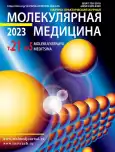Proliferotropic effect of combinations of short peptides and encoded amino acids in organotypic tissue culture of various origins
- Authors: Chalisova N.I.1,2, Ivanova P.N.1, Egozova E.S.3
-
Affiliations:
- Institute of Physiology named after I.P. Pavlova RAS
- St. Petersburg Institute of Bioregulation and Gerontology
- Russian State Pedagogical University named after. A.I. Herzen
- Issue: Vol 21, No 5 (2023)
- Pages: 47-51
- Section: Original research
- URL: https://journals.eco-vector.com/1728-2918/article/view/622787
- DOI: https://doi.org/10.29296/24999490-2023-05-07
- ID: 622787
Cite item
Abstract
Introduction. An urgent problem in biology and medicine is the identification of biologically active molecules that affect the cellular processes of proliferation and apoptosis in various tissues of the body.
Purpose of the study. The purpose of this study was to identify the effect of combinations of encoded amino acids and short peptides in organotypic tissue culture of various genesis of young (3-month-old) and old (18-month-old) rats.
Method. The method of organotypic cultivation of tissues of mesodermal origin (cartilage, kidney, testes) and ectodermal origin (pancreas) of rats was used for rapid screening of the biological activity of the studied substances.
Results. It has been established that the combined use of amino acids and short peptides enhances their proliferative effect, which leads to a potentiating effect of the drugs used.
Conclusion. The data obtained create the basis for the targeted development of new drugs, including geroprotective ones, for the treatment of pathologies of the nervous and immune systems.
Full Text
About the authors
Natalia I. Chalisova
Institute of Physiology named after I.P. Pavlova RAS; St. Petersburg Institute of Bioregulation and Gerontology
Author for correspondence.
Email: ni_chalisova@mail.ru
ORCID iD: 0000-0002-2371-0043
Expert Scientific Worker of the I.P. Pavlov Institute of Physiology RAS; Expert Scientific Worker of the Laboratory of Oncogerontology of Biogerontology Department of Saint Petersburg Institute of Bioregulation and Gerontology, Doctor of Biologic Sciences, Professor
Russian Federation, emb. Makarova, 6, St. Petersburg, 199034; Dynamo Ave., 3, St. Petersburg, 197110Polina N. Ivanova
Institute of Physiology named after I.P. Pavlova RAS
Email: ivanovapolina19@mail.ru
ORCID iD: 0000-0001-7112-0673
Scientific Worker of Petersburg Institute of Bioregulation and Gerontology
Russian Federation, emb. Makarova, 6, St. Petersburg, 199034Ekaterina S. Egozova
Russian State Pedagogical University named after. A.I. Herzen
Email: ekaterina_egozova@mail.ru
ORCID iD: 0000-0002-0055-3778
Magister
Russian Federation, emb. R. Moiki, 48, St. Petersburg, 191186References
- Рыжак А.П., Чалисова Н.И., Линькова Н.С. Влияние полипептидов на регенерацию клеток в культуре разных тканей молодых и старых крыс. Успехи геронтологии. 2015; 28 (1): 97–103. [Rizhak G.A., Chalisova N.I., Linkova N.S. Polypeptide effect on cellular regeneration in different tissue culture of young and old rats. Advances in Gerontology. 2015; 28 (1): 97–103 (In Russian)].
- Журкович И.К., Ковров Н.Г., Рыжак Г.А., Миронова Е.С., Хавинсон В.Х. Идентификация коротких пептидов в составе полипептидных комплексов, выделенных из органов животных. Успехи современной биологии. 2020; 140 (2): 140–8. doi: 10.31857/S004213242002012X. [Zhurkovich I.K., Kovrov N.G., Rizhak G.A., Mironova E.S., Khavinson V. Rh. Identification of short peptides in the composition of polypeptide complexes from animal organs. Advances of modern biology. 2020; 140 (2): 140–8. doi: 10.31857/S004213242002012X (In Russian)].
- Khavinson V.Kh., Tendler S.M., Kasyanenko N.A. Tetrapeptide KEDW Interacts with DNA and Regulates Gene Expression. Am. J. Biomed. Sci. 2015; 7 (3): 156–69.
- Ashapkin V., Khavinson V., Shilovsky G., Linkova N., Vanuyshin B. Gene expression in human mesenchymal stem cell aging cultures: modulation by short peptides. Mol. Biol. Rep. 2020; 47 (6): 4323–9. doi: 10.1007/s11033-020-05506-3
- Чалисова Н.И., Концевая Е.А., Войцеховская М.А. Регуляторное влияние кодируемых аминокислот на основные клеточные процессы у молодых и старых животных. Успехи геронтологии. 2011; 2: 189–97. [Chalisova N.I., Koncevaya E.A., Voicekhovskaya M.A. Regulating effect of coded amino acids on main cellular processes in young and old animals. Advance in gerontology. 2011; 2: 189–97 (In Russian)].
- Aftabuddin Md., Kundu, S. Hydrophobic, hydrophilic, and charged amino acid networks within protein. Biophysical J. 2007; 93: 225–31. https://www.doi.org/10.1529/biophysj.106.098004.
- Fedoreyeva L.I., Kireev I.I., Khavinson V.Kh., Vanyushin B.F. (2011) Penetration of short fluorescence-labeled peptides into the nucleus in HeLa cells and in vitro specific interaction of the peptides with deoxyribooligonucleotides and DNA. Biochemistry. 2011; 76 (11): 1210–9.
- Vanyushin B.F., Khavinson V.Kh. Short Biologically Active Peptides as Epigenetic Modulators of Gene Activity. Epigenetics – A Different Way of Looking at Genetics. W. Doerfler, P. Böhm (eds.). Springer International Publishing Switzerland. 2016; 69–90.
- Vladimir Khavinson, Natalia Linkova, Oleg Ivko. AEDG Peptide Regulates the Expression of Circadian Genes Clock, Cry2, Csnk1e in Human Immune Cells. World heart J. 2021; 13 (1): 189–93.
Supplementary files






